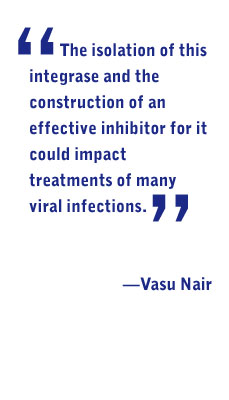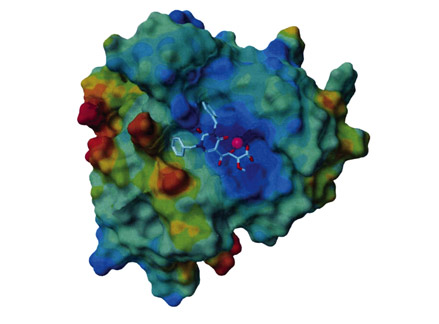


Fighting the System
by Carole VanSickle
Intro
| Breaking the Chain
| New Drug Alternatives

![]()
Special Delivery: Getting a Drug to the Right Place

New Drug Alternatives
Nair believes that vaccinating against HIV or completely eliminating the virus from the human body once the infection has been introduced would be difficult, if not impossible. “I don’t really think that we’ll ever develop a single truly effective vaccine because the virus has multiple forms,” he said. By inhibiting replication of the virus while the viral counts are still low, however, a drug can render HIV almost entirely impotent. Almost entirely blocking viral replication could dramatically change patients’ and doctors’ treatment options, which now often include costly and painful injections, constant pill administration and occasionally near-fatal side effects. Not so if Nair’s work continues in its current vein. “Like diabetics who measure blood-sugar levels and take insulin on a regular basis, a person infected with HIV would be able to monitor viral counts and medicate accordingly,” Nair said.
Moreover, this basic approach need not be limited to HIV. “Maybe the most interesting thing about our discovery is its ramifications for other viruses,” Nair said. Because HIV is a retrovirus — meaning that it injects its genetic material into a host cell, then takes advantage of the infected cells’ machinery to manufacture more viral invaders — targeting this integrase may work to halt the progress of other retroviruses, such as the virus that causes feline leukemia and several other kinds of tumor-causing, retroviral infections.

Nair’s conceptually new inhibitor (stick model at center, with the magnesium ion indicated as a red sphere) is shown binding to the catalytic core of HIV-1 integrase in this electrostatic potential map.
“The isolation of this integrase and the construction of an effective inhibitor for it could impact treatments of many viral infections, as the basic design concepts from our discovery can be modified and applied to other retroviruses and other DNA viruses,” Nair said.
Nair acknowledges that drug targeting and discovery is a complicated process. Side effects, for example, are a major concern when focusing on new targets for drugs. Before clinical trials — which test the safety and effectiveness of a treatment — can begin, extensive toxicity studies in pre- clinical trials are required.
“It does me no good to invent a ‘cure-all’ that kills the patient in the process,” he said. “But the good news about HIV integrase is that it has no parallel in the human body, so this may lower the likelihood of harmful side effects arising from a drug targeting this enzyme.”
By contrast, AZT, a common treatment for HIV/AIDS, targets an enzyme called reverse transcriptase that is involved in viral DNA replication. Because humans also replicate their DNA, the drug interferes with this replication as well as the viral process, resulting in some very nasty side effects such as anemia, nausea, severe muscle weakness and extreme fatigue. “After some period of time working with reverse-transcriptase inhibitors, we decided to look elsewhere and try to disable the enzyme that actually gets the genetic information into the host’s genetic code,” Nair said.
Currently, Nair and his colleagues are starting the sixth of nine stages of testing the new treatment. “We’ve done extensive work with the isolated enzyme and also with the inhibitor and the enzyme together in cells,” he said. “Now we have to do animal studies.” The first series of animal studies does not involve infected animals, but rather is an analysis of how animals — usually mice or rats — react to the drug itself and also how long it remains in their systems. “You look at how they absorb the drug, how and if they eliminate it and whether or not it’s still in one piece on the other side,” said Nair. “You don’t want a drug that breaks down when it enters the body.”
“This molecule has spectacular anti-HIV potential,” Nair said. “We’ve got some years left before it gets to clinical trials, but for now everything is proceeding very well.”
For more information, email Vasu Nair at vnair@rx.uga.edu.
Intro
| Breaking the Chain
| New Drug Alternatives
For comments or for information please e-mail: rcomm@uga.edu
To contact the webmaster please email: ovprweb@uga.edu
![]()